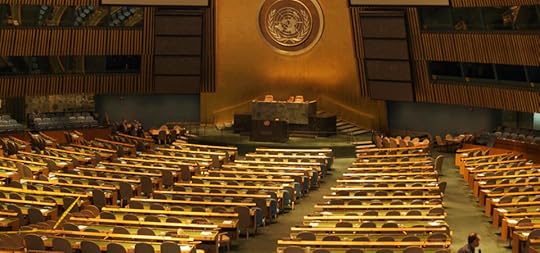Steve Bull's Blog, page 1199
February 6, 2018
ECB “In Touch With Market Participants” Over Market Crash; White House “Concerned”
In a double whammy of panic about the fate of the artificial “wealth effect” created thanks to $20 trillion in central bank liquidity, officials at both the White House and Europe’s largest hedge fund expressed concerns about the market rout that saw the Dow suffer its biggest point drop in history.
According to Bloomberg, ECB staff “have been in contact with market participants over the current selloff in stocks to gauge if there is any risk to financial stability.”
As Bloomberg adds, the latest communications are part of the ECB’s regular interactions with financial institutions and the central bank isn’t yet overly concerned by the global equity rout. The underlying assumption is that “it’s simply a correction because valuations may have become overstretched.”
Of course, if the VIX explosion continues, the ECB will be far more worried.
As a result, staff are “watching for signs the downturn might enter a self-reinforcing spiral or spread from equities to bonds.”
One worry is that the selloff was triggered by strong U.S. economic data that led to expectations of faster interest-rate increases, a symptom that financial markets are still relying on monetary support, one of the people said.
Meanwhile, across the Atlatnic, White House Spokeswoman Mercedes Schlapp said on Fox that “obviously we’re concerned about setbacks that happened in the stock market” however, she was quick to hedge that “with that being said, we’re looking at the long term strong economic fundamentals.”
Seeking to distance the White House from Trump’s relentless boasting about every uptick and sudden silence now that stocks have crashed, she instead decided to sound like your typical, worthless sellside analyst, and said that people should focus on “improving fundamentals” instead:
…click on the above link to read the rest of the article…
Trump Administration to Test Biometric Program to Scan Faces of Drivers and Passengers in Vehicles
 The U.S. Customs and Border Protection is preparing to launch a pilot program to scan the faces of drivers and passengers at Anzalduas Port near McAllen, Texas.
The U.S. Customs and Border Protection is preparing to launch a pilot program to scan the faces of drivers and passengers at Anzalduas Port near McAllen, Texas.
On Thursday the U.S. Customs and Border Protection announced plans for a new pilot program that will test out biometric facial recognition technology as part of an effort to identify fugitives or terror suspects. The Austin-American Statesman reported on the announcement:
Thanks to quantum leaps in facial recognition technology, especially over the past year, the future is arriving sooner than most Americans realize. As early as this summer, CBP will set up a pilot program to digitally scan the faces of drivers and passengers — while they are in moving vehicles — at the busy Anzalduas Port of Entry outside of McAllen, the agency announced Thursday.
The Texas-Mexico border is being used as the testing grounds for the technology. The results of the pilot program will be used to help roll out a national program along the entire southern and northern borders. The Statesman notes that the Department of Energy hired researchers at Tennessee’s Oak Ridge National Laboratory to help overcome the difficulties of using facial recognition technology on moving vehicles. The researchers developed a method for combating window tinting and sun glare which can make a vehicle’s windows impenetrable to cameras. The facial recognition technology being developed for the pilot program will be capable of identifying the driver, front passengers, and the passengers riding in the back.
The CBP currently operates facial recognition exit programs at almost a dozen international airports in the United States. Colleen Manaher, the CBP’s executive director of planning, program analysis and evaluation, told the Statesman that travelers have been accepting of the technology and noted that “we can thank the Apples and the Googles for that.”
…click on the above link to read the rest of the article…
‘Cosmo-Localization’: Can Thinking Globally and Producing Locally Really Save Our Planet?

‘COSMO-LOCALIZATION’: CAN THINKING GLOBALLY AND PRODUCING LOCALLY REALLY SAVE OUR PLANET?
Fablabs, makerspaces, emerging global knowledge commons… These are but some of the outcomes of a growing movement that champions globally-sourced designs for local economic activity. Its core idea is simple: local ownership of the means to produce basic manufactures and services can change our economic paradigm, making our cities self-sufficient and help the planet.
Sharon Ede, urbanist and activist based in Australia has recently launched AUDAcities, a catalyst for relocalising production in cities. She shared her insights on the opportunities of making cities regenerative and more sustainable as well as the limits of cosmo-localization.
TECHNOLOGY, AS WE ALL KNOW, IS NOT NEUTRAL. MAKING THE TRANSITION TO SELF-SUFFICIENT CITIES NEEDS A CULTURAL SHIFT, NOT JUST A TECHNOLOGICAL ONE. SO, HOW DO WE DESIGN OPEN-SOURCE TOOLS THAT FOSTER A CHANGE IN BEHAVIOURS AND ARE INCLUSIVE?
Technology will go where cultural, social and economic values direct it. A cultural shift will include open source tools, and the kinds of processes we need to create those – but a cultural shift will require much more.
Governments can and do play a significant role in shaping culture through policy and regulation, and contrary to popular belief about where innovation originates, the state is not only a key entrepreneurial actor but also has a huge opportunity to reinvent itself as the ‘partner state’ – where government responds to the contributory democracy we are seeing emerge as a force that does with, not for or to, the communities it serves.The technology, and who owns it, is just a manifestation of what we value.
THERE HAS BEEN A LOT OF DEBATE ABOUT THE REAL BENEFITS OF LOCAL PRODUCTION, ESPECIALLY THAT LAST-MILE DELIVERY IS MORE HARMFUL TO THE ENVIRONMENT THAN THE BENEFITS IT BRINGS. IN YOUR EXPERIENCE, WHAT IS THE ECOLOGICAL FOOTPRINT OF A PRODUCT THAT HAS BEEN GLOBALLY DESIGNED AND LOCALLY MANUFACTURED?
…click on the above link to read the rest of the article…
Inefficient productivity or productive inefficiency?
New research demonstrates – again – how deceptive the concepts of productivity and efficiency are in agriculture. Huge increases in labor productivity and modest increases in land productivity are gained by a massive increase of use of external resources, while natural capital is depleted. Is that efficient?
There is a growing body of research measuring resource flows to better understand the impact of developments. It is argued that only if economic growth can become substantially decoupled from material use, waste, and emissions, it can be sustainable. By measuring total use of resources, the total social metabolism, of the economy and not just measuring one parameter, one can avoid being distracted by the fact that usage of one resource has declined, while others have increased.
A sub set of the metabolism of society is the agrarian metabolism which refers to the exchange of energy and materials between a given society and its agrarian environment. In the article The agrarian metabolism as a tool for assessing agrarian sustainability, and its application to Spanish agriculture (1960-2008) in ECOLOGY AND SOCIETY, January 2018, Gloria I. Guzman (Universidad Pablo de Olavide) and colleagues assess how the metabolism of Spanish agriculture has changed through the increased use of mechanization, irrigation, chemical fertilizers and massive use of imported animal feed, to mention the most important drivers.
We are told again and again that modern agriculture and the Green revolution are wonders of efficiency and productivity. But when one look closer into the Spanish figures they give a different picture.
The researchers studied the use of external inputs such as nitrogen (N), phosphorus (P), potassium (K), carbon (C), and energy flows, as well as the “fund elements” that they sustain such as soil, biodiversity, and woodland. The results show that the growing use of external inputs has broken the equilibrium between land and biomass uses required by traditional farming and broken or made redundant internal loops of energy and nutrients.
…click on the above link to read the rest of the article…
A Proposal for a United Nations Framework Convention on Population Growth

The United Nations Meeting Room by Keith Burns | Flickr | CC BY-NC-ND 2.0
Introduction
Recently, an international assembly of scientists from 184 countries endorsed an article published in the journal Bioscience entitled “World Scientists’ Warning to Humanity: A Second Notice”. As the warning states, “We are jeopardizing our future by not reining in our intense but geographically and demographically uneven material consumption and by not perceiving continued rapid population growth as a primary driver behind many ecological and even societal threats. By failing to adequately limit population growth, reassess the role of an economy rooted in growth, reduce greenhouse gases, incentivize renewable energy, protect habitat, restore ecosystems, curb pollution, halt defaunation, and constrain invasive alien species, humanity is not taking the urgent steps needed to safeguard our imperilled biosphere.”Further, this 2016 article published in the Chinese Journal of Population Resources and Environment presents an instructive discussion of why population growth remains largely unacknowledged as a primary driver behind such threats. And this 2010 article published in The Globalist introduces then dissects ‘Ponzi Demography’, asserting that “the sooner nations reject Ponzi demography and make the needed gradual transition from ever-increasing population growth to population stabilization, the better the prospects for all of humanity and other life on this planet.”
As Population Media Center’s President Bill Ryerson asserts, population is the multiplier of everything else. Such knowledge demands action to protect life on Earth in a compassionate and intentional manner. People are receptive to this inclusive message. It compels us to act together.
I propose the establishment of a United Nations Framework Convention on Population Growth –one akin to the Paris Agreement for climate change with Nationally Determined Contributions (NDCs) in pursuit of a sustainable population in every country.
…click on the above link to read the rest of the article…
Constructing Hope: A Discussion of “Green Earth”

Neither hope nor its cousin joy are to be confused with optimism. The latter tends to be more a quality of temperament than a realistic assessment of prospects. As for the former, well, you have to go looking for them, or even, laboriously, construct them for yourself, at best in the company of other people. By combining found materials with what you’ve got with you—like, say, dried grass and twigs with the flint and steel in your backpack—you can, with effort, spark and and nourish a little flame that, once going, you’ve still got to work to maintain.
That’s been my project lately, in our seriously dystopic times, when my most innocuous activities—biking to work, leading woods restoration workdays for students, working on sustainability projects—sometimes feel like political activism. There’s no need to enumerate the ways that the actions of those recreating atop the federal government threaten not only civil society but also the biosphere’s wellbeing. For earth-centered folks who include human wellbeing in the definition of planetary health, there are daily blows, even as it grows clearer that the doors to an environmentally whole future, in which global warming and its effects are somewhat mitigated, are rapidly swinging shut.
Well, then. Where to go looking? One’s active work one counts greatly, though the slowness and difficulty of that work can get disheartening. And I’m seeing a resurgence of outright, vocal, practical commitment to sustainable policy and practice grounded in local efforts by individuals, community groups, municipalities and states. This could help bend our society towards a sustainable arc. There is evidence that if 10% of a given population subscribes to a particular idea, theory or principle, or changes a way of doing something a whole group or society will change.
…click on the above link to read the rest of the article…
Is the 9-Year Long Dead Cat Bounce Finally Ending?
Ignoring or downplaying these fundamental forces has greatly increased the fragility of the status quo.
The term dead cat bounce is market lingo for a “recovery” after markets decline due to fundamental reversals. Markets tend to bounce back after sharp declines as participants (human and digital) who have been trained to “buy the dips” once again buy the decline, and the financial media rushes to reassure everyone that nothing has actually changed, everything is still peachy-keen wonderfulness.
I submit that the past 9 years of market “recovery” is nothing but an oversized dead cat bounce that is finally ending. Here is a chart that depicts the final blow-off top phase of the over-extended dead cat bounce:

Why are the past 9 years nothing but an extended dead cat bounce? Nothing that’s fundamentally broken has been fixed, and none of the dynamics that are undermining the status quo have been addressed.
The past 9 years have been one long dead cat bounce of extend and pretend, i.e. do more of what’s failed because to even admit the status quo is being undermined by fundamental forces would panic those gorging at the trough of the status quo’s lopsided rewards.
This 9-year dead cat bounce was pure speculation driven by cheap central bank credit and liquidity. Demographics, environmental degradation, the decline of middle class security, the erosion of paid work, the bankruptcy of public and private pension plans, the global debt bubble, soaring wealth and income inequality, the corruption of democracy into a pay-to-play bidding war, the destruction of price discovery via market manipulation by those who have turned markets into signaling devices that all is well, the laughable distortion of statistics to mask the real world decline in our purchasing power (inflation is near-zero–really really really), the perverse incentives to leverage up bets in financial instruments that have no connection to the real-world economy–none of these have been addressed in the market melt-up.
…click on the above link to read the rest of the article…
If There’s a War in Korea, Blame Trump
Brainwashed Americans believe that Kim Jong-un is responsible for the confrontation between Pyongyang and Washington, but nothing could be further from the truth. The real problem is not Kim’s nuclear weapons but Washington’s 65 year-long military occupation that continues to reinforce a political solution that was arbitrarily imposed on a sovereign nation in order to split the country in two, install a puppet regime in the south, establish a permanent military presence to defend US commercial interests, and maintain control of a strategically-located territory that is a critical part of Washington’s plan to encircle Russia and China to remain the dominant global power throughout the century. Simply put, Washington is 100 percent responsible for the current confrontation just as it has been responsible for every flare-up for the last 7 decades.
Even so, fighting back against the relentless outpouring of US-backed state propaganda is no easy task. So allow me to defend the position of the DPRK with just one, brief analogy that will help to put things into perspective:
Imagine if the Korean army decided to deploy tens of thousands of combat troops to fight on the side of the South during the Civil War. And let’s say, that these forces were so successful that they were able to kill 3 million Americans while reducing every business and factory, every home and hospital, every church and university, to smoldering rubble. As a result of Korean meddling, the North was unable to win the war, but was forced to settle for an armistice that permanently split the US into North and South allowing Korea to install its stooges in the capitol of Richmond while it established military bases in every southern state from Virginia to Louisiana.
…click on the above link to read the rest of the article…
Nuclear Reactors, Bankrupting Their Owners, Closing Early
On January 22, FirstEnergy Corporation announced that its faulty and nearly-self-destructed Davis-Besse power reactor east of Toledo, Ohio, will be closed well before its license expires. But the shutdown is not because the reactor represents reckless endangerment of public health and safety. FirseEnergy was fine with that. No, the old rattle trap can’t cover its costs any more, not with the electricity market dominated by cheaper natural gas, and renewable wind and solar.
Davis-Besse’s early shutdown date has not been announced, but CFO James Pearson of FirstEnergy Nuclear Operating Co., the corporate division in charge of the wreck, said the reactor will close if lawmakers don’t approve a taxpayer bailout.
FirstEnergy had said the financial sky was falling in March 2017. Chief nuclear officer Sam Belcher [his real name] told the Toldeo Blade then — as the firm was floating the bailout measure (SB 128) through the Ohio legislature — “In the absence of something happening, [taxpayer-funded handout to the private, investor-owned firm] we’re going to have to make some tough decisions.” So far, state lawmakers have refused to save the decrepit reactor with state taxes. They cite old-fashioned market competition, and the failure of previous subsidies to save the mature, well-established reactor industry once led by the now bankrupt Westinghouse.
Serious accidents at David-Besse in 1977, 1985, 1998, and 2002 endangered its neighbors. The most hair-raising was the discovery in 2002 that corrosion had eaten through more than 6-inches of the reactor head’s carbon steel. The corrosion went undetected by federal and company inspectors for decades. Having gouged a hole in the reactor cover the size of a football, the corrosion left only 3⁄8 inch of steel holding back the high-pressure coolant. A break would have caused a massive loss-of-coolant accident and out-of-control overheating, resulting in catastrophic uranium fuel melting (known as a “meltdown”) and massive radiation releases.
…click on the above link to read the rest of the article…
The Increasing Likelihood Of Nuclear War Should Straighten Out All Our Priorities

A Russian pilot has been killed by US-armed terrorists in Syria. The Ron Paul Institute‘s Daniel McAdams writes the following about this new development:
“The scenario where a US-backed, US-supplied jihadist group in Syria uses US weapons to shoot down a Russian plane and then murders the pilot on the ground should be seen as a near-nightmare escalation, drawing the US and Russia terrifyingly closer to direct conflict.”
McAdams is not fearmongering; he is stating a plainly obvious fact. The Trump administration has just announced that it is restructuring its nuclear weapons policy to take a more aggressive stance toward Russia than that which was held by the previous administration. This is coming after this administration’s decision to arm Ukraine against Russia, a move Obama refused to take for fear of escalating tensions with Moscow, as well as its decision to continue to occupy Syria in order to effect regime change, along with numerous other escalations. The Council on Foreign Relations, which is without exaggeration as close to the voice of the US establishment as you can possibly get, is now openly admitting that the “United States is currently in a second Cold War with Russia.”
In a recent interview with The Real News, leading US-Russian relations expert Stephen Cohen repeated his ongoing warning that “this new Cold War is much more dangerous, much more likely to end in Hot War, than was the 40-year of Cold War, which we barely survived.” In a previous interviewwith the same outlet, Cohen elaborated more extensively:
…click on the above link to read the rest of the article…



